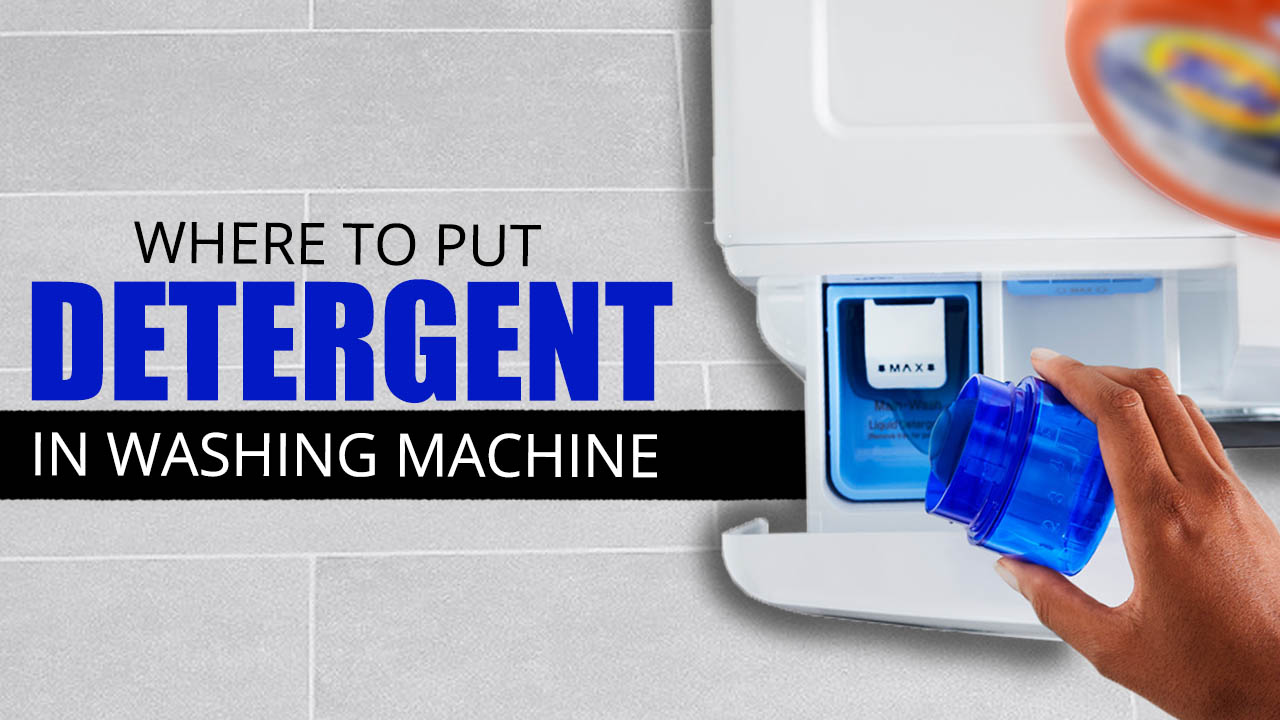Washing machines have come a long way since early models required laundry to be washed by hand. Today, most of the best washing machines come with a variety of detergent options, making it easy to get a perfect clean for your clothes. However, with all these different choices, it can be tricky to know where to put detergent in your washing machine. In this article, we’ll give you a step-by-step guide on how to load detergent into your machine, so you can get the best results for your laundry.
Where to put detergent in a washing machine?
If you’re like most people, you probably don’t give much thought to where you put the detergent in your washing machine. However, the location of the detergent can have a big impact on how well your clothes get clean. In general, it’s best to put the detergent in the Dispenser Drawer, which is usually located at the top or front of the machine. This way, the detergent will be slowly released into the wash water as the cycle starts, giving it time to dissolve and work on dirt and stains.
However, if you’re using a powder detergent, you may want to put it directly into the drum of the machine before adding clothes. This will help to prevent clumping and ensure that the detergent is evenly distributed. No matter which method you choose, always follow the manufacturer’s instructions to ensure that your clothes come out looking their best.
Where to put detergent in top load washing machine?
For the best top load washing machine, you will typically add your laundry detergent to the water as it is filling up in the tub. Some units have a small tray or compartment that is designed specifically for holding the detergent. If your machine does not have this feature, simply pour the detergent into the tub once the water has reached the desired level.
Once the detergent has been added, you can then add your clothing and start the cycle. In general, it is best to use a high-efficiency laundry detergent to reduce water and energy consumption. However, if you are using a non-healing washing machine, you may need to use a different type of detergent to prevent damage to your clothing. Consult your owner’s manual for more information on which type of detergent to use.
Washing machine detergent drawer
Most front-load washing machines have a detergent drawer with different compartments for different types of detergent and washing aids. It’s important to make sure you put the right kind of detergent in the right compartment, as using the wrong type of detergent can damage your clothes or the machine itself.
The detergent drawer may be slightly different depending on the model, but usually there is a compartment for powder detergent, liquid detergent, and fabric softener. You may also find a compartment for pre-wash aids such as stain removers or colour-safe bleaches.
Make sure you read the instructions on your detergent before using it, as some types need to be added directly to the machine drum rather than the detergent drawer. With a little bit of care, you can ensure that your clothes are always cleaned properly, and that your washing machine stays in good condition.
What are the 3 compartments in a washing machine drawer?
The 3 compartments in a washing machine drawer are for pre-wash detergent, main wash detergent, and fabric softener respectively.
Pre-wash detergent compartment
The pre-wash detergent compartment is used to hold a small amount of laundry detergent, which is dispensed into the wash cycle before the main wash cycle begins. The pre-wash detergent helps to remove any stubborn stains or dirt before the main wash cycle starts, making your clothes cleaner and brighter.
Many modern washing machines have a pre-wash detergent compartment, and it is typically marked with an icon or symbol. If you are unsure whether your best front load washing machine in India has a pre-wash detergent compartment, consult the owner’s manual for more information.
Main wash detergent compartment
Every washing machine has a main wash detergent compartment. This is where you add the laundry detergent that will clean your clothes. The main wash cycle is typically the longest cycle on the washing machine, and it is during this cycle that your clothes will undergo the most vigorous cleaning.
As a result, it is important to use the correct amount of detergent in the main wash compartment. If too much detergent is used, it can cause excessive sudsing and leave a residue on your clothes. If too little detergent is used, your clothes may not come clean. Therefore, it is important to follow the manufacturer’s instructions when adding detergent to the main wash compartment.
Fabric softener compartment
A fabric softener is a product that is used to soften clothes and reduce static cling. It is typically applied during the rinse cycle of laundry. The active ingredient in fabric softener is usually a cationic quaternary ammonium compound. This molecule binds to the fibres in fabric, making them softer and less likely to produce static electricity. Fabric softeners can be applied in liquid or dry form.
Dryer sheets are impregnated with fabric softener and can be used to soften clothes as they are tumble-dried. Liquid fabric softeners are typically added to the washing machine during the rinse cycle. Many laundry detergents now incorporate fabric softener into their formulas so that clothes are softened, and static cling is reduced in one step.
Auto-dispense unit
An automatic dispenser is a device that adds a specific amount of laundry detergent, fabric softener, or other cleaning agent to the wash water of a washing machine automatically at the appropriate time in the cycle.
This can be done either by measuring the amount of water that enters the machine and dispensing the appropriate amount of chemicals based on that measurement or by monitoring the stages of the wash cycle and adding chemicals at specific intervals. Many automatic dispensers have settings that allow the user to select the desired amount of product to be dispensed.
Type one or type two detergent drawer
The type one detergent drawer has 3 separate compartments. One each for pre-wash detergent, main wash detergent and fabric softener. The softener compartment is the one in the middle and the pre-wash and main wash compartments are on the either side.
In the type two detergent drawer, there are two compartments. The first one is the main-wash compartment. The second compartment is divided into 2 halves. The first half is the pre-wash, and the second half is the fabric softener.
Washing machine detergent drawer symbols
The washing machine detergent drawer has 3 symbols. Here’s what each of them signifies.
- The single standing line or ‘I’ symbol is used for pre-wash.
- The double standing lines or ‘II’ symbol is used for main wash.
- The flower symbol is used for the fabric softener.
How to use the detergent compartments of the washing machine?
The washing machine is a very handy household item, particularly if you have a large family to wash clothes for. However, understanding how to use it is vital in order to maximise washing, save electricity and detergents, and guarantee that the machine lasts as long as possible. You can get some guidance and information on how to utilise the detergent compartments correctly by reading this tutorial.
1. Follow the instructions
It is critical to always follow the instructions in the washing machine’s instruction booklet. If the instruction booklet is misplaced, the instructions for detergent dose might be retrieved from another washing machine because they are so similar. It is recommended that you do not put detergent beyond the little pad with the word MAX inscribed on one of the drawer’s walls.
2. Use the right amount of detergent
Excess detergent does not improve the scent or cleanliness of the clothes; on the contrary, it might harm the washing machine. Each section in the drawer has a specific purpose, such as bleach, detergent, or fabric softener. The most recent washing machines, logically, have drawers in various positions and shapes; for example, the detergent drawer in a top loading washing machine has been moved near the door.
3. Do not exceed dosages
It is critical to follow the recommendations while washing with bleach; otherwise, the incorrect dosage can destroy your garments. The detergent drawer might be combined with a second one that would be placed within. When liquid detergent is used, it can be poured into the compartment with or without the addition of a tray in this manner. If you pour the liquid without an additional tray, you must pour it into the compartment at the last possible minute.
4. Use the additional trays
In fact, if you opt to pour it earlier, you risk it vanishing because it will glide straight inside ahead of schedule. As a result, it is recommended that you utilise the additional tiny tray in this scenario, which essentially serves to progressively dosage the input of liquid detergent during the washing process.
If you want to use powder detergent, you’ll have to take out the extra container. Optimizing the usage of liquid detergent is all that is required. Only when the water pushes the powder detergent into the washing machine, at the correct moment of washing, does it fall into the machine.
How to dose the detergent in the washing machine?
In terms of home economics, there are several basic measures that can be useful both in terms of saving money and in terms of storing appliances for a long time. Considering this, the next sections in this article include some basic but helpful advice for dosing detergent in the washing machine.
1. Use a measuring cup
Let’s start by saying that liquid detergents come with a particular dosing cap that doubles as a measuring cup; in truth, a small amount is enough for each load of laundry. In this regard, it is vital to note that the dosage will vary depending on the amount of the dirt and the type of fabric. It is critical to utilise water at the proper temperature so that the heat can thoroughly dissolve the particles that make up the cleaning ingredient, resulting in the best possible result for washing.
2. Use a dosing ball
A common blunder is to use the same amount washing detergent for every load, regardless of how soiled the clothing are. It’s not the same as washing work clothes that are highly dirty with grease or grass stains if your garments merely need a refresh. As a result, adjustments must be made to maximize detergent savings while reducing energy use.
The detergent must be placed, among other things, in the collection tray of the washing machine, which will be mechanically circulated by the machine during washing, or in the typically plastic dosing ball that is inserted directly into the washing machine drum in the middle of the laundry. The plastic ball serves as a measuring cup and has markings on the outside that indicate the measurements.
3. Mix the detergent with other substances
Mixing the detergent with other substances is another great approach to dose it in the washing machine while also saving money because it reduces the amount of detergent used. At fact, if sodium bicarbonate or citric acid are added to the product, the tray will require less space.
Finally, if you have various soap residues around the house, you can use them by drying them and then shredding them while doing the laundry by placing the flakes in the tray. Adding a softener also allows you to dosage the detergent into the washing machine; in fact, the product can be added to the tray using the measuring cap if purchased at a supermarket.
4. Opt for the detergent in tabs
Tabs of detergent are nothing more than disposable, extremely soluble capsules with a biodegradable coating that release a concentrated amount of detergent once dissolved. Because its formula is more compact, including only what is truly required, this sort of product has been intended to reduce waste of natural resources.
The tablet is thus more advantageous from an economic and environmental standpoint, without forgetting that it is a particularly practical washing system, because it does not dirty hands, it is placed directly in the basket, and it contains calibrated doses on average for a load of 5 kg. If the load is greater, such as 8 kg, another must be added.
5. The right temperature
It may sound unusual to state that washing at temperatures above 60 degrees is inefficient, but the enzymes in the detergent are destroyed at such high temperatures. The temperature of 60 degrees enables for the destruction of even the most resistant microorganisms, making it ideal for clothing worn by sick persons or those contaminated by chemical agents.
The ideal temperature is 30 degrees; at this temperature, germs and bacteria are eliminated, and the garments are thoroughly cleaned. The recommendation is to use a longer washing cycle with low temperatures rather than the other way around, so that we conserve electricity and enable the detergent to work for longer.
6. The softener
For many people, using fabric softener to wash garments and make them soft, silky, and scented is virtually a necessity. Fabric softeners, especially towels and washcloths, contain chemicals that are damaging to the environment and, in the long term, make garments less absorbent. Because fabric softeners can cause dermatitis and skin allergies in some people, it’s best to read the label carefully and choose more environmentally friendly options.
Conclusion
Many people are unsure about where to put detergent in their washing machine. The most important thing to remember is that you should always add detergent to the water before adding clothes. This will help to prevent the detergent from damaging your clothes. Additionally, it is important to use the correct amount of detergent.
Too much detergent can damage your clothes and leave behind a residue, while too little detergent will not clean your clothes effectively. Once you have added the detergent, you can add your clothes and start the washing cycle. By following these simple tips, you can ensure that your clothes are cleaned effectively without being damaged.
Frequently asked questions (FAQs)
1. How much detergent to use in washing machine?
The amount of detergent you’ll need to use in your washing machine depends on a few factors, including the size of your load, the type of detergent you’re using, and the level of soiling on your clothes. Generally, you’ll want to use between one and two tablespoons of laundry detergent per wash cycle. If you’re using a concentrated laundry detergent, you may only need to use one teaspoon per wash cycle. If your clothes are very soiled, you may need to use more detergent. Be sure to follow the instructions on your laundry detergent bottle to ensure that you’re using the right amount.
2. Where to put liquid detergent in washing machine?
Most washing machines have a compartment for liquid detergent. The location of this compartment may vary depending on the model of your machine, but it is usually located either on the door or on the side of the machine. Consult your washing machine’s manual if you are unsure of where to find the compartment.
3. Does washing machine need special detergent?
No, you don’t need to use special detergent for your washing machine. You can use any type of detergent that you would use for hand-washing your clothes. Just be sure to follow the directions on the package and use the correct amount of detergent. If you have any concerns, consult your washing machine’s owner’s manual.
4. Which is better for washing machine liquid or powder?
There is no clear consensus on which type of detergent is better for washing machines. Some people swear by liquid detergent, while others prefer powder. Ultimately, the best detergent to use in a washing machine depends on the specific machine and the needs of the user. Some people find that liquid detergent is more effective at getting clothes clean, while others find that powder detergent is better at removing stains.
5. Is fabric softener necessary?
No, fabric softener is not necessary. You can use it if you want to, but it’s not required. Fabric softener can help to make your clothes feel softer and smell nicer, but it’s not necessary for cleaning them. If you don’t want to use fabric softener, you can just skip that step in your laundry routine.
6. Is it possible to wash clothes with dish detergent in washing machine?
No, it is not recommended to wash clothes with dish detergent in washing machine as it can damage the machine. Dish detergent is designed for dishes and not for clothes. Washing your clothes with dish detergent can cause the colors to bleed and the fabric to become damaged. It is better to use a laundry detergent that is specifically designed for washing clothes.






